I HAVE been reading with interest the various articles in narrowboatworld regarding CaRT’s ‘cover-up’ and feel I must comment, writes Allan Richards.
The reason for this is that I was one of the people making information requests that have led to heavily censored inspection reports being made available to the public. This includes the '95% blacked-out' reports linked from Victor:You should not have said that mate—Sunday 6th October.
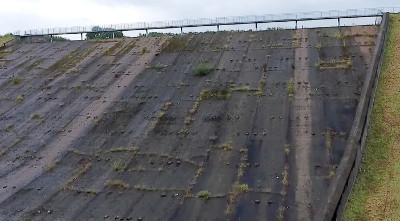 Deflecting blame
Deflecting blame
The Reservoirs Act 1975 makes it quite clear that the responsibility for public safety of the Toddbrook reservoir lies with CaRT whilst regulation is the responsibility of the Environment Agency. My interest in the Toddbrook incident was sparked by a very early attempt by CaRT to deflect responsibility from themselves onto the shoulders of an independent engineer carrying out a ten year survey in accordance with the Act:-
‘It also undergoes a detailed ten yearly inspection by an independent Inspecting Engineer—the last one at Toddbrook took place in November 2018. The independent November inspection did not identify any immediate repairs needed to the spillway.’ (The above photograph was taken by a resident of Whaley Bridge two years before the collapse.)
Needless to say, CaRT did not provide the survey...
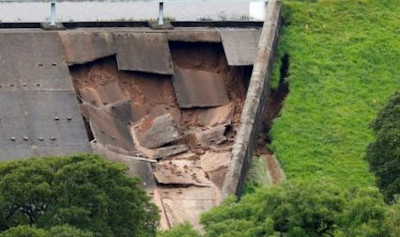 Trying to blame him
Trying to blame him
It occurred to me that CaRT were not saying that the independent engineer had given the spillway or the dam a clean bill of health. Rather, it appeared, they were trying to blame him for not alerting them that the spillway was in imminent danger of failure and ordering them to carry out immediate repairs.
As such, a request was made for the independent inspection report and its predecessor. CaRT were also asked to provide information related to bi-annual and twice weekly inspections thus covering the three cycles of inspection carried out. The reason for asking for this further information was due to concerns that vegetation up to a metre high had been allowed to grow out of the joints between the auxiliary spillways concrete slabs. Whilst this may or may not have a bearing on the failure, it does show a sloppy disregard for basic maintenance.
Unbeknown to me at the time, others, including Whaley Bridges residents, were also asking the Trust and the Environment Agency for inspection information.
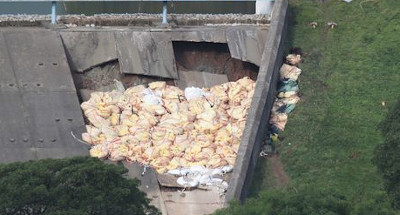 Golden opportunity
Golden opportunity
It was, of course, a golden opportunity for CaRT and EA to demonstrate that they had nothing to hide and no concerns were being expressed about the reservoir, its dam or its spillways in the various reports. In the event, they blew it by failing to respond to information requests within the 20 working days as required by law. When chased by the Information Commissioner to respond, they blew it again by providing heavily redacted (i.e. blacked-out) reports claiming that it was in the public interest to withhold most of the contents.
Regulation 12(5)(a)
CaRT responded to my information requests using Environmental Information Regulations instead of the more familiar Freedom of Information Act. It withheld information under:-
“Regulation 12(5)(a)—on the basis that disclosure would adversely affect national security and public safety. The Trust has considered the public interest test in relation to the application of this exception.
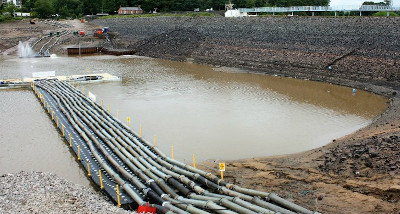 The factors in favour of withholding the information are that during the current heightened status of threat to national security, there is a high level of public interest in not releasing information that would result in a threat to public safety. If the Trust were to release copies of these reports, which were not redacted, it would be releasing key details of the infrastructure and potential vulnerabilities of the Toddbrook Reservoir. This would prejudice the protection and safety of the public through potential damage or disruption to the national infrastructure by acts of sabotage.
The factors in favour of withholding the information are that during the current heightened status of threat to national security, there is a high level of public interest in not releasing information that would result in a threat to public safety. If the Trust were to release copies of these reports, which were not redacted, it would be releasing key details of the infrastructure and potential vulnerabilities of the Toddbrook Reservoir. This would prejudice the protection and safety of the public through potential damage or disruption to the national infrastructure by acts of sabotage.
The factors in favour of disclosure are that there is a general presumption of openness and a need to promote accountability and transparency, taking into account the public interest in this reservoir.
The Trust has considered whether the information is already in the public domain and in the case of information in these reports, it is not. We have considered the contribution that the release would make to public debate and have sought to release as much information as possible in order to allow the public to engage in debate and to be transparent in the regulation of reservoirs. However, the Trust has determined that the factors in favour of withholding the information outweigh the public interest factors in disclosing the information.”
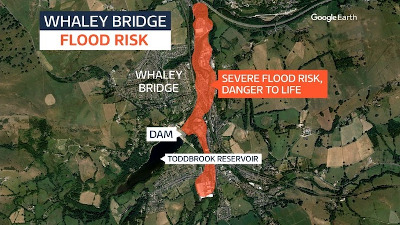 Let’s not beat about the bush here. In a nutshell, the authorities would have us believe that releasing information at this time would encourage terrorists to attack the Toddbrook reservoir by providing them with information which would allow them to do so more effectively.
Let’s not beat about the bush here. In a nutshell, the authorities would have us believe that releasing information at this time would encourage terrorists to attack the Toddbrook reservoir by providing them with information which would allow them to do so more effectively.
What a nonsense!
Current heightened status of threat?
Does the heightened status of threat to national security claimed by CaRT and EA actually exist? Not according to the Security Services (MI5) website. Its threat level history downgraded the international terrorism threat from ‘CRITICAL’ to ‘SEVERE’ two years ago, on 17th September 2017. Likewise, threat in Great Britain from Northern Ireland related terrorism was downgraded from ‘SUBSTANTIAL’ to MODERATE on 1st March 2018.
Threat level has lowered rather than heightened! Why pretend otherwise?
Further information regarding terrorist methods can be found at https://www.mi5.gov.uk/terrorist-methods and terrorist targets at https://www.mi5.gov.uk/terrorist-targets
Terrorist attack
During the ‘Troubles’, the Provisional Irish Republican Army (IRA) and other republican groups carried out nearly 500 attacks in England, most of them in London. I lived and worked in London in the late 60’s early 70’s and, like many others, had a number of near misses. Sadly, some were less fortunate...
As such, I would refrain from criticising CaRT and EA if I thought that even a remote possibility of a terrorist attack at Toddbrook reservoir could be executed with loss of life or major damage to infrastructure.
At the moment, terrorists attacks in the UK tend to be ‘low-tech’ using knives and vehicles. Whilst the threat of bomb attacks still exists, as does attacks using methods not seen before in the UK, I still fail to see how Toddbrook could be considered a target because it is non-operational.
Drained
Toddbrook reservoir has been drained down and pumps are in place to keep the capacity at less 10%. It can, therefore, be considered as being in a non-operational or decommissioned state. Even if the pumps currently on site were sabotaged it would take weeks of rain to fill the reservoir. Once full the dam would then have to be sabotaged again to ensure failure. The worst case scenario would be Whaley Bridge inundated resulting in loss of life and damage to ‘national infrastructure’ (whatever that means), private property and the environment.
However, one suspects that in the weeks before the level of the reservoir rose to a critical level, pumps would be repaired or new pumps installed...
The current best estimate is that Toddbrook will remain in a non-operational or decommissioned state for three years whilst the dam is reconstructed.
Are we really expected to believe that claimed ‘potential vulnerabilities’ will be taken into account during the reconstruction of the dam?
Deflecting the blame again
Faced with criticism in both national and local press regarding its heavy handed censorship of inspection documents, again CaRT is blaming a third party. This time its the EA. After three weeks silence on its Toddbrook Reservoir update webpage, CaRT had this to say:-
'Following the lead of the Environment Agency we have now made available last November’s inspection report into Toddbrook Dam. For national security reasons laid down by the Agency, the regulator in England and Wales, the report has had to be heavily redacted. We understand the frustration but are obliged to follow national guidelines on this which are exactly the same for any other of the nation’s 2,000 plus reservoirs'.
Despite the Information Commissioner telling CaRT is must respond to Toddbrook information requests, CaRT is trying to suggest that its disclosures are voluntary and that full disclosure has somehow been prevented by the Environment Agency.
Needless to say, it does not actually provide links to this information it claims to have made available.
The national security card
By playing the national security card to prevent the release of information, both CaRT and EA are entering dangerous waters. Toddbrook’s use is leisure—to supply water for leisure boating on its downstream canals with a bit of sailing and fishing on the reservoir thrown in.
... and what of all the other high risk reservoirs that only provide for leisure needs?
If the terrorist threat gains credence, then Whaley Bridge residents will oppose the rebuilding of the dam. Toddbrook Reservoir will become Toddbrook Marsh or, worse still, sold off to developers.
Is this what CaRT wants?
Further information
Whilst it is understood that several requests have been made of EA and CaRT, the following reports are the only ones believed to be in the public domain. They were provided to Allan Richards following the intervention of the Information Commissioner and can be found on the whatdotheyknow.com website
Heavily redacted Reservoir Surveillance Inspection reports:
https://www.whatdotheyknow.com/request/594779/response/1437385/attach/4/2141%20001.pdf
Two heavily redacted reports carried out by an independent inspector:
https://www.whatdotheyknow.com/request/594764/response/1436310/attach/4/2010%20S10.pdf
https://www.whatdotheyknow.com/request/594764/response/1436315/attach/4/2019%20S10.pdf
